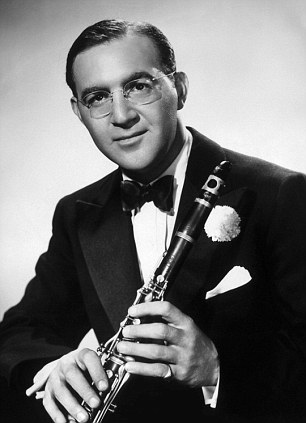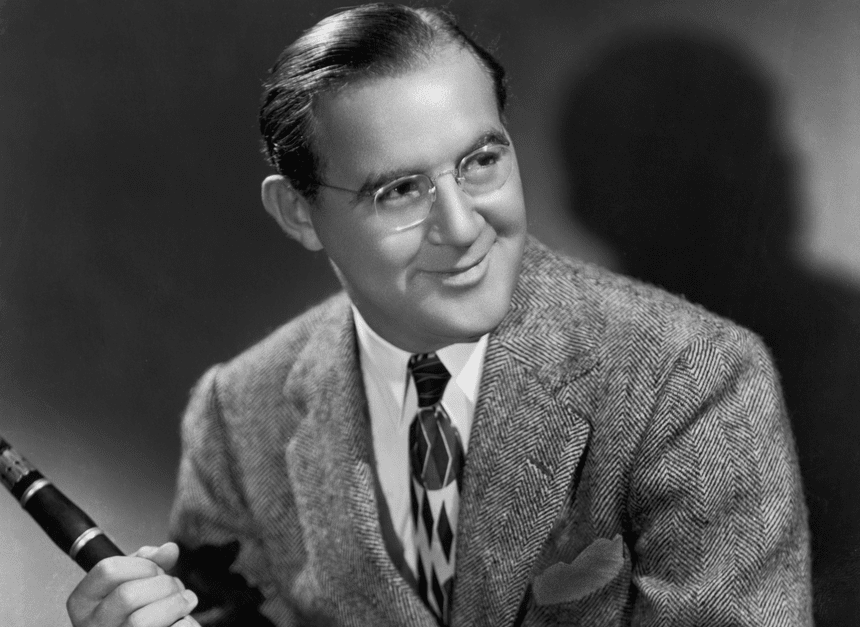Benny Goodman
Benjamin David " Benny " Goodman ( * May 30, 1909 in Chicago, Illinois, † June 13, 1986 in New York City ) was an American jazz musician ( clarinet ) and bandleader. Especially in the 1930s, he celebrated with his big band great success and is considered one of the most popular protagonists of swing.
Life and work
Goodman was born in Chicago, the son of poor Jewish immigrants. The age of ten he got a clarinet and lessons in Kehelah -Jacob Synagogue. For two years, taught him Franz Schoepp from the Chicago Symphony Orchestra. At twelve, he was already playing in theater orchestras and in various dance bands in the city. During his high school years he joined in 1922 with the Austin High School gear on. His jazz teachers were the great soloists and bands of the 1920s, including King Oliver's Creole Jazz Band with Louis Armstrong and the representatives of the Chicago jazz. Goodman got into one of the leading bands in Chicago then a, the Ben Pollack Orchestra, with which he went on tour in 1926 and made his first recordings, including on the 9th of December, the first recording of a clarinet solos played by him (He 's the Last Word ). Two years later he moved to New York City where he worked for the radio and as a session musician, including for Ben Selvin and Paul Whiteman and as a theater musician on Broadway.
In January 1931, he had with his gramophone recording of the song He's Not Worth Your Tears a first chart hit (# 20). For the radio series Let's Dance clarinetist formed his first big band in 1934, the combined white and black musicians for the first time in the history of jazz. With her perfection she achieved within a few years the recognition not only of jazz fans, but also many music lovers outside of the Jazz range, for example in Mozart concerts. However, the major breakthrough in the audience was denied him for the time being. In the early 1930s he played with the nationally known bands of Red Nichols, Isham Jones, and Ted Lewis.
From 1933 he had for Columbia more hits like Fats Waller Ain'tcha Glad (# 6) and the songs I Gotta Right to Sing the Blues ( # 20) and I Is not Lazy, I'm Just Dreaming ( # 6) with Jack Teagarden as a band singer. In June 1934, Moonglow he succeeded the first of its sixteen number - one hits. During this time, Glenn Miller played with as a freelance trombonist. It was not until 1935 at the Palomar Ballroom he experienced with his own band the breakthrough and now traveled from success to success.
On January 16, 1938 Goodman then gave his famous jazz concert (see The Famous Carnegie Hall Concert 1938) in New York's Carnegie Hall. The concert was a resounding success, which jazz was almost overnight socially acceptable and even in the " finer circles " increasingly accepted. The recording of the concert, in particular the long closing track Sing, Sing, Sing, is now regarded as a milestone and an important genre classic and found years ago inclusion in the select circle of the Hall of Fame of jazz.
From 1934-1938 Goodman recorded for the label Victor, which later changed its name under the name RCA Victor. From 1939, his records were released on Columbia Records, who have released first concert Goodman at Carnegie Hall. For Victor he took one of his biggest hits on, Edgar Sampson Do not Be That Way, who was five weeks at No. 1 and stayed 13 weeks in the charts. In addition to Stompin 'at the Savoy, this was the number that had to play for his audience Goodman again and again.
In addition to his big band in which, among other things, the star trumpeter Harry James and Ziggy Elman played, he also founded the Benny Goodman Quartet, which united the jazz greats Teddy Wilson, Gene Krupa and Lionel Hampton. In this quartet played with Teddy Wilson and Lionel Hampton two black musicians together with two white musicians, which was a taboo at that time.
The music of bandleader Benny Goodman was geared primarily to highlighting him in his role as a soloist on the clarinet, although he also always, about Helen Ward or Ella Fitzgerald, had other outstanding soloists and vocalists in his band. Although Goodman was no innovator about the rank of Duke Ellington or Count Basie, it originate only relatively few of his pieces from his own pen. The meticulous arrangements of his title, however, were usually very catchy and so he could with his virtuosic playing in the circle of well-rehearsed band mates and certainly based on skin color then reach a larger audience than this. Stylistically his music marked the mainstream of swing and along with fellow clarinet playing Artie Shaw he was the most popular white bandleader of the swing era, who still enjoyed great success in the postwar period.
Many music critics now believe that Goodman for jazz and swing has the same meaning such as Elvis Presley in the rock ' n ' roll. Benny Goodman had to bring the goal of "black" music to a young white audience closer, and he has thereby also made an exemplary contribution to the overcoming of racial segregation in the United States, because in the early thirties were black and white jazz musicians in most bands or do not play together in concerts, due to the public opinion. This he had made possible in his own big band. Even so he is now regarded as the King of Swing.
Representatives of the so-called " serious music " as Paul Hindemith, Aaron Copland, Malcolm Arnold and Béla Bartók have dedicated works to him. Benny Goodman himself played classical music, such as the Clarinet Concerto K. 622 and the Clarinet Quintet K. 581 by Wolfgang Amadeus Mozart.
Private life
Goodman was in 1942 with Alice Hammond Duckworth, sister of producer John Hammond, married; from the relationship derived two daughters.
Movies
About Benny Goodman was the 1955 film The Benny Goodman Story rotated ( Director: Valentine Davies), with Steve Allen in the title role. Goodman himself once remarked to the fact that the music was very good, the biography, however, do not agree. 2011 documentary Jazz for the Russians was - To Russia with Jazz released on Goodman's USSR tour in 1962.
Disco Graphical Notes
Collections
- Classic Columbia and Okeh Benny Goodman Orchestra Session (1939-1958) - ( Mosaic - 2008) - 7 CDs with Ziggy Elman, Chris Griffin, Corky Cornelius, Vernon Brown, Toots Mondello, Jerry Jerome, Fletcher Henderson, Artie Bernstein, Nick Fatool, Charlie Christian, Johnny Guarnieri, Fred Astaire, Lionel Hampton, Cootie Williams, Lou McGarity, Georgie Auld, Mike Bryan, Cutty Cutshall, Bernie Leighton, Teddy Wilson, Hymie Schertzer, Count Basie, Dave Tough, Billy Butterfield, Jo Jones, Mel Powell, Sid Catlett, Vido Musso, Bernie Privin, Sid White, Dave Barbour, Trummy Young, Aaron Sachs, Clyde Lombardi, Morey field, Slam Stewart, Bud Freeman, Johnny Best, Kai Winding, Stan Getz, Peanuts Hucko, Buddy Rich, Joe Bushkin, Zoot Sims, Barney Kessel, Bob Haggart, Johnny Smith, Paul Smith, George Van Eps, Mundell Lowe, Eddie Safranski, Don Lamond, Buck Clayton, Doc Severinsen, Hank Jones, George Duvivier
- The Complete Capitol Small Group Recordings of Benny Goodman 1944-1955 ( Mosaic - 1994) 6 LPs, 4 CDs with Teddy Wilson, Cozy Cole, Jess Stacy, Dave Barbour, Peggy Lee, Jimmy Rowles, Benny Carter, Charlie Shavers, Red Norvo, Irving Ashby, Red Callender, Don Lamond, Mel Powell, Louis Bellson, Wardell Gray, Fats Navarro, Mundell Lowe, Buddy Greco p & voc, Clyde Lombardi, George Duvivier, Jo Jones, Ruby Braff, Lionel Hampton
Works (excerpt)
Goodman was known especially for his interpretations of foreign compositions. He had to share numerous compositions, which he combines with the members of his bands - developed - especially in the smaller settings. Of particular note here are the musician Lionel Hampton ( vibraphone) and Charlie Christian ( electric guitar ). Less often it is occupied as the sole composer.
- AC - DC Current ( Christian - Hampton - Goodman)
- Air Mail Special ( Mundy - Christian - Goodman)
- Do not Be That Way ( Goodman - Sampson - Parrish )
- Flying Home ( Goodman - Hampton - Robin )
- Opus 1 /2 ( Goodman - Hampton - Wilson - Tough )
- Opus 3/4 ( Goodman - Hampton)
- Opus Local 802 ( Goodman)
- Pick- A- Rib, Pts. 1-2 ( Goodman)
- Seven Come Eleven ( Goodman - Christian )
- Smoke House Rhythm ( Goodman - Norman )
- Soft Winds ( Goodman)
- Vibraphone Blues ( Goodman - Hampton)










